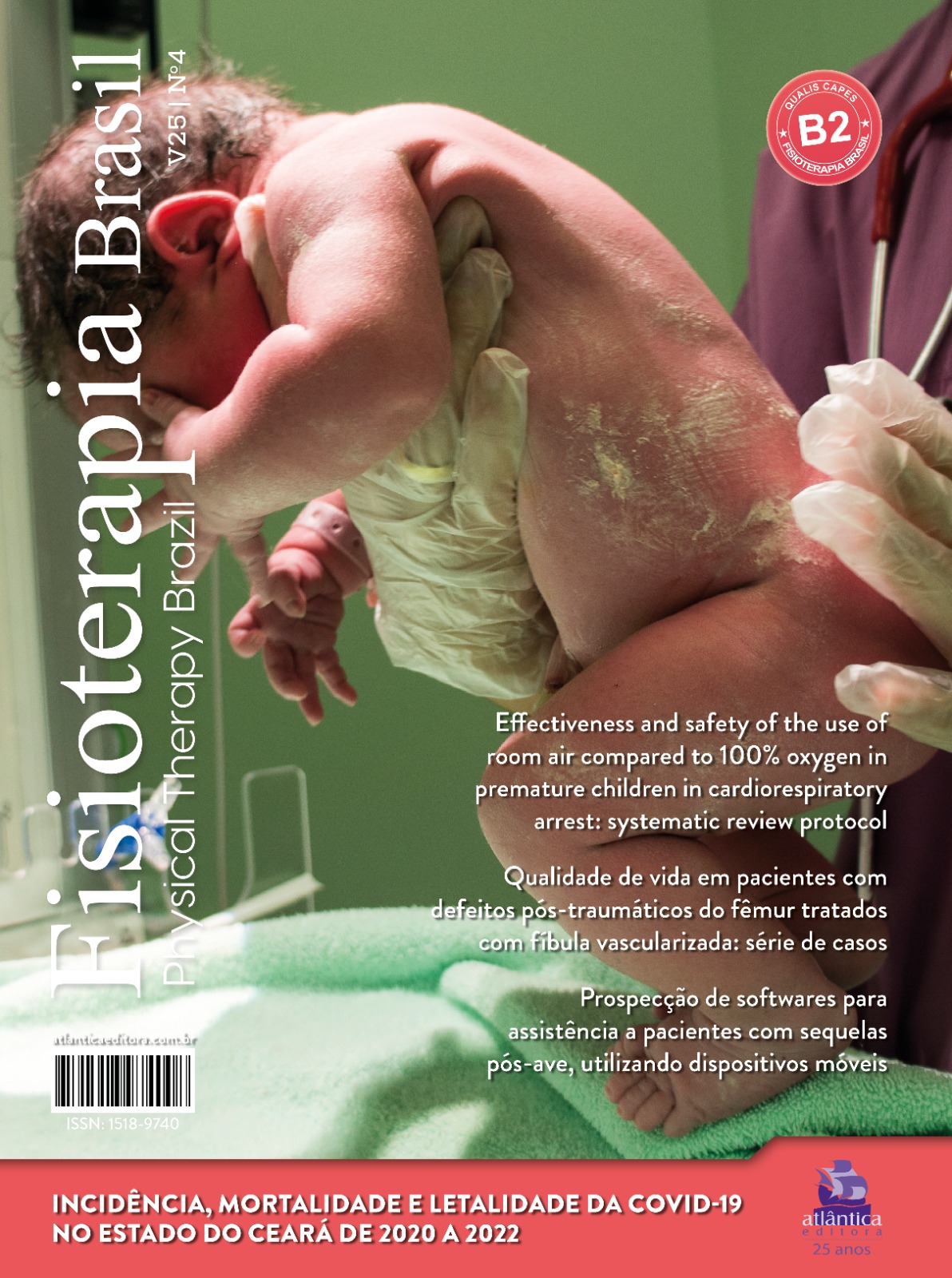Effectiveness and safety of the use of room air compared to 100% oxygen in premature children in cardiorespiratory arrest: systematic review protocol
DOI:
https://doi.org/10.62827/fb.v25i4.1018Palabras clave:
Heart arrest; infant premature; systematic review.Resumen
Introduction: Cardiorespiratory arrest is a clinical situation characterized by the interruption of blood circulation. It is estimated that 11.1% of all live births in the world are premature, generating short and long-term repercussions. One of the main challenges during cardiacarrest in premature infants is providing sufficient, but not excessive, oxygen during assisted ventilation. Objective: To compare the effectiveness and safety of using room air in relation to 100% oxygen in the resuscitation of premature infants in cardiorespiratory arrest. Methods: To this end, we will carry out a systematic review of randomized clinical trials (RCTs). The study protocol was registered on the Prospero Platform (CRD42024519724). We will include preterm infants with gestational age <37 weeks with CA. The searches were carried out in the following databases: Medical Literature Analysis and Retrieval System Online (MEDLINE) via Pubmed, Excerpta Médica dataBASE (Embase) via Elsevier, Cochrane Central Register of Controlled Trials (CENTRAL) via Cochrane Library, Latin American Literature and the Caribbean Doctor in Health Sciences (LILACS) through the Virtual Health Library Portal, without restrictions on language or year of publication. The selection of studies, transmission of data, assessment of the bias of included studies and assessment of the certainty of the evidence will be carried out by two independent investigators. Expected Results: Clarify the transit and safety of using room air compared to 100% oxygen, provide useful information for clinical decision-making, and support future high-quality randomized clinical trials on the topic. Conclusion: This study aims to compile existing research to analyze the effectiveness and safety of application of 100% oxygen in the resuscitation of premature infants.
Referencias
Chang HH, Larson J, Blencowe H, Spong CY, Howson CP, Cairns-Smith S, et al. Preventing preterm births: Analysis of trends and potential reductions with interventions in 39 countries with very high human development index. The Lancet. 2013;381(9862):223–34.
Walani SR. Global burden of preterm birth. Vol. 150, International Journal of Gynecology and Obstetrics. John Wiley and Sons Ltd.; 2020. p. 31–3.
Sperotto F, Daverio M, Amigoni A, Gregori D, Dorste A, Allan C, et al. Trends in In-Hospital Cardiac Arrest and Mortality Among Children With Cardiac Disease in the Intensive Care Unit. JAMA Netw Open. 2023 Feb 10;6(2):e2256178.
Cao Y, Jiang S, Sun J, Hei M, Wang L, Zhang H, et al. Assessment of Neonatal Intensive Care Unit Practices, Morbidity, and Mortality Among Very Preterm Infants in China. JAMA Netw Open. 2021 Aug 2;4(8):e2118904.
Coggins SA, Haggerty M, Herrick HM. Post-cardiac arrest physiology and management in the neonatal intensive care unit. Resuscitation. 2021;169.
del Castillo J, López-Herce J, Matamoros M, Cañadas S, Rodriguez-Calvo A, Cechetti C, et al. Hyperoxia, hypocapnia and hypercapnia as outcome factors after cardiac arrest in children. Resuscitation. 2012 Dec;83(12):1456–61.
Ophelders DRMG, Gussenhoven R, Klein L, Jellema RK, Westerlaken RJJ, Hütten MC, et al. Preterm Brain Injury, Antenatal Triggers, and Therapeutics: Timing Is Key. Cells. 2020 Aug 10;9(8):1871.
Guerra-Wallace MM, Casey FL, Bell MJ, Fink EL, Hickey RW. Hyperoxia and hypoxia in children resuscitated from cardiac arrest. Pediatric Critical Care Medicine. 2013 Mar;14(3).
Ramji S, Rasaily R, Mishra PK, Narang A, Jayam S, Kapoor AN, et al. Resuscitation of asphyxiated newborns with room air or 100% oxygen at birth: A multicentric clinical trial. Indian Pediatr. 2003;40(6).
Schmidt AR, Ramamoorthy C. Bronchopulmonary dysplasia. Pediatric Anesthesia. 2022 Feb 15;32(2):174–80.
Alten JA, Klugman D, Raymond TT, Cooper DS, Donohue JE, Zhang W, et al. Epidemiology and outcomes of cardiac arrest in pediatric cardiac ICUs. Pediatric Critical Care Medicine. 2017;18(10).
Oei JL, Saugstad OD, Lui K, Wright IM, Smyth JP, Craven P, et al. Targeted Oxygen in the Resuscitation of Preterm Infants, a Randomized Clinical Trial. Vol. 139, PEDIATRICS. 2017.
Thamrin V, Saugstad OD, Tarnow-Mordi W, Wang YA, Lui K, Wright IM, et al. Preterm Infant Outcomes after Randomization to Initial Resuscitation with FiO 2 0.21 or 1.0. Journal of Pediatrics. 2018 Oct 1;201:55-61.e1.
Armanian A, Badiee Z. Resuscitation of preterm newborns with low concentration oxygen versus high concentration oxygen. J Res Pharm Pract. 2012;1(1):25.
Soraisham AS, Srivastava A. Recent Update on Neonatal Resuscitation. Vol. 89, Indian Journal of Pediatrics. Springer; 2022. p. 279–87.
Higgins JPT, Thomas J, Chandler J, Cumpston M, Li T, Page MJ, et al. Cochrane Handbook for Systematic Reviews of Interventions. Cochrane Handbook for Systematic Reviews of Interventions. Wiley; 2019. doi: 10.1002/9781119536604
Schünemann HJ, Higgins JPT, Vist GE, Glasziou P, Akl EA, Skoetz N, et al. Completing ‘Summary of findings’ tables and grading the certainty of the evidence. In: Cochrane Handbook for Systematic Reviews of Interventions [Internet]. Wiley; 2019. p. 375–402. Available from: https://onlinelibrary.wiley.com/doi/10.1002/9781119536604.ch14
Descargas
Publicado
Número
Sección
Licencia
Derechos de autor 2024 Ingrid Nazaré Lourinho Alves, Gabriely Cristina Sousa dos Anjos, Alice de Sousa Amoras Távora, Ana Carolina Pereira Nunes Pinto, Natalia Iosimuta (Autor)

Esta obra está bajo una licencia internacional Creative Commons Atribución 4.0.
Autores que publicam nesta revista concordam com os seguintes termos:
Autores mantém os direitos autorais e concedem à revista o direito de primeira publicação, com o trabalho simultaneamente licenciado sob a Licença Creative Commons Attribution 4.0 que permite o compartilhamento do trabalho com reconhecimento da autoria e publicação inicial nesta revista.
Autores têm autorização para distribuição não-exclusiva da versão do trabalho publicada nesta revista (ex.: publicar em repositório institucional ou como capítulo de livro), com reconhecimento de autoria e publicação inicial nesta revista.



